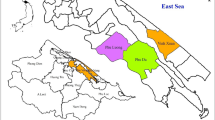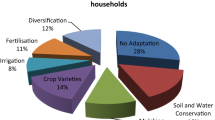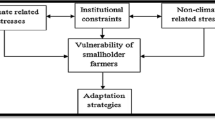Abstract
The purpose of this paper is to examine the impact of community-based organizations (CBOs) on the adoption of agricultural adaptations to climate change impacts. To this end, we first analyze farmers’ perceptions on changes in local climatic condition, its impact and adaptations on agriculture based on information collected through a questionnaire survey of 720 farming households in six districts of Nepal. The findings reveal a widespread feeling of weather getting warmer, decreasing precipitation, and increasing weather unpredictability. It is found that climate change has adversely affected agriculture in Nepal, and farmers have adopted various adaptation practices to minimize the impacts. Second, we employ propensity score matching technique to examine the impact of CBOs on climate change adaptation. About 62% of the sampled farming households were associated with CBOs, and several socioeconomic factors influence such association. This study provides evidence supporting the argument that CBOs play important role in reducing the negative impacts of climate change by enhancing the adoption of adaptation strategies. It is also evident from the study the need of further strengthening and institutionalizing the informal farmers’ groups and institutions for the successful adaptation.

Similar content being viewed by others
Notes
In Nepal, agriculture is a dominant sector, contributing about 35% of total gross domestic product and employing 70% of the population in the country.
Other matching algorithms include Epanechnikov kernel matching, caliper and radius matching, stratification and interval matching (Khandker et al. 2009).
A VDC is an administrative unit in Nepal similar to a municipality which is further divided into nine wards. Each ward constitutes one to several villages.
These questions were also included in the household survey questionnaire.
These indicators were identified from FGDs with farmers in the study area before the household survey.
In this study, we define registered CBOs as the CBOs that are registered and affiliated with the local government organizations such as District Agriculture Development Office, District Development Committees, and District Soil Conservation Office.
References
Abebaw, D., & Haile, M. G. (2013). The impact of cooperatives on agricultural technology adoption: Empirical evidence from Ethiopia. Food Policy, 38, 82–91.
Adger, W. N., Huq, S., Brown, K., Conway, D., & Hulme, M. (2003). Adaptation to climate change in the developing world. Progress in Development Studies, 3(3), 179–195.
Adhikari, K. P., & Goldey, P. (2010). Social capital and its “downside”: The impact on sustainability of induced community-based organizations in Nepal. World Development, 38(2), 184–194.
Alam, M., & Regmi, B. R. (2004). Adverse impacts of climate change on development of Nepal: Integrating adaptation into policies and activities. Capacity strengthening in the least developed countries for adaptation to climate change. Working paper no. 3.
Amare, M., Asfaw, S., & Shiferaw, B. (2012). Welfare impacts of maize–pigeonpea intensification in Tanzania. Agricultural Economics, 43(1), 27–43.
Ayers, J., & Forsyth, T. (2009). Community-based adaptation to climate change. Environment: Science and Policy for Sustainable Development, 51(4), 22–31.
Bandara, J. S., & Cai, Y. (2014). The impact of climate change on food crop productivity, food prices and food security in South Asia. Economic Analysis and Policy, 44(4), 451–465.
Becerril, J., & Abdulai, A. (2010). The impact of improved maize varieties on poverty in Mexico: A propensity score-matching approach. World Development, 38(7), 1024–1035.
Becker, S. O., & Ichino, A. (2002). Estimation of average treatment effects based on propensity scores. The Stata Journal, 2(4), 358–377.
Below, T. B., Mutabazi, K. D., Kirschke, D., Franke, C., Sieber, S., Siebert, R., et al. (2012). Can farmers’ adaptation to climate change be explained by socio-economic household-level variables? Global Environmental Change, 22(1), 223–235.
Bravo-Ureta, B. E., Almeida, A. N., Solís, D., & Inestroza, A. (2011). The economic impact of MARENA’s investments on sustainable agricultural systems in Honduras. Journal of Agricultural Economics, 62(2), 429–448.
Bryan, E., Deressa, T. T., Gbetibouo, G. A., & Ringler, C. (2009). Adaptation to climate change in Ethiopia and South Africa: Options and constraints. Environmental Science & Policy, 12(4), 413–426.
Caliendo, M., & Kopeinig, S. (2008). Some practical guidance for the implementation of propensity score matching. Journal of Economic Surveys, 22(1), 31–72.
Cameron, A. C., & Trivedi, P. K. (2005). Microeconometrics: Methods and applications. Cambridge: Cambridge University Press.
Chaudhary, P., & Bawa, K. S. (2011). Local perceptions of climate change validated by scientific evidence in the Himalayas. Biology Letters, rsbl20110269.
Conley, T. G., & Udry, C. R. (2010). Learning about a new technology: Pineapple in Ghana. The American Economic Review, 100(1), 35–69.
Deressa, T. T., Hassan, R. M., Ringler, C., Alemu, T., & Yesuf, M. (2009). Determinants of farmers’ choice of adaptation methods to climate change in the Nile Basin of Ethiopia. Global Environmental Change, 19(2), 248–255.
Di Falco, S., Veronesi, M., & Yesuf, M. (2011). Does adaptation to climate change provide food security? A micro-perspective from Ethiopia. American Journal of Agricultural Economics, 93(3), 829–846.
Easterling, W., Aggarwal, P., Batima, P., Brander, K., Bruinsma, J., Erda, L., . . . Baethgen, W. (2007). Food, Fibre, and Forest Products. In M. L. Parry, O. F. Canziani, J. P. Palutikof, P. J. van der Linden & C. E. Hanson (Eds.), Climate change 2007: Impacts, adaptation and vulnerability. contribution of working group II to the fourth assessment report of the intergovernmental panel on climate change (pp. 273–313). Cambridge: Cambridge University Press.
Faltermeier, L., & Abdulai, A. (2009). The impact of water conservation and intensification technologies: Empirical evidence for rice farmers in Ghana. Agricultural Economics, 40(3), 365–379.
Feder, G., Anderson, J. R., Birner, R., & Deininger, K. (2010). Promises and realities of community-based agricultural extension community, market and state in development (pp. 187–208). London: Palgrave Macmillan.
Finger, R., Hediger, W., & Schmid, S. (2011). Irrigation as adaptation strategy to climate change—a biophysical and economic appraisal for Swiss maize production. Climatic Change, 105(3–4), 509–528.
Fischer, E., & Qaim, M. (2012). Linking smallholders to markets: Determinants and impacts of farmer collective action in Kenya. World Development, 40(6), 1255–1268.
Fischer, E., & Qaim, M. (2014). Smallholder Farmers and Collective Action: What Determines the Intensity of Participation? Journal of Agricultural Economics, 65(3), 683–702.
Forsyth, T. (2013). Community-based adaptation: A review of past and future challenges. Wiley Interdisciplinary Reviews: Climate Change, 4(5), 439–446.
Fünfgeld, H. (2015). Facilitating local climate change adaptation through transnational municipal networks. Current Opinion in Environmental Sustainability, 12, 67–73.
Harmer, N., & Rahman, S. (2014). Climate change response at the farm level: A review of farmers’ awareness and adaptation strategies in developing countries. Geography Compass, 8(11), 808–822.
Huang, J., Wang, Y., & Wang, J. (2015). Farmers’ adaptation to extreme weather events through farm management and its impacts on the mean and risk of rice yield in China. American Journal of Agricultural Economics, 97(2), 602–617.
Huq, S., Reid, H., Konate, M., Rahman, A., Sokona, Y., & Crick, F. (2004). Mainstreaming adaptation to climate change in least developed countries (LDCs). Climate Policy, 4(1), 25–43.
IPCC. (2001). Climate change 2001: impacts, adaptation, and vulnerability: Contribution of working group II to the third assessment report of the intergovernmental panel on climate change. Cambridge University Press.
Kassie, M., Jaleta, M., Shiferaw, B., Mmbando, F., & Mekuria, M. (2013). Adoption of interrelated sustainable agricultural practices in smallholder systems: Evidence from rural Tanzania. Technological Forecasting and Social Change, 80(3), 525–540.
Khanal, U., Wilson, C., Hoang, V. N., & Lee, B. (2018). Farmers’ adaptation to climate change, its determinants and impacts on rice yield in Nepal. Ecological Economics, 144, 139–147.
Khandker, S. R., Koolwal, G. B., & Samad, H. A. (2009). Handbook on impact evaluation: Quantitative methods and practices. World Bank Publications.
Khatri-Chhetri, A., Joshi, N. M., & Maharjan, K. L. (2007). Intervention on livelihood management through community-based organizations: Evidence from rural Nepal. Journal of International Development and Cooperation, 13(1), 187.
Korten, D. C. (1980). Community organization and rural development: A learning process approach. Public Administration Review, 40, 480–511.
Leuven, E., & Sianesi, B. (2015). PSMATCH2: Stata module to perform full Mahalanobis and propensity score matching, common support graphing, and covariate imbalance testing. Chestnut Hill: Statistical Software Components, Boston College Department of Economics.
Malla, G. (2009). Climate change and its impact on Nepalese agriculture. Journal of Agriculture and Environment, 9, 62–71.
Mendelsohn, R., Dinar, A., & Williams, L. (2006). The distributional impact of climate change on rich and poor countries. Environment and Development Economics, 11(02), 159–178.
MoE. (2010). National adaptation programme of action to climate change. Kathmandu: Ministry of Environment.
MoE. (2011). Climate change policy, 2011. Kathmandu: Ministry of Environment.
Morton, J. F. (2007). The impact of climate change on smallholder and subsistence agriculture. Proceedings of the National Academy of Sciences, 104(50), 19680–19685.
Nelson, G. C., Rosegrant, M. W., Koo, J., Robertson, R., Sulser, T., Zhu, T., et al. (2009). Climate change: Impact on agriculture and costs of adaptation (Vol. 21). Washington: International Food Policy Research Institute.
Nyangena, W. (2008). Social determinants of soil and water conservation in rural Kenya. Environment, Development and Sustainability, 10(6), 745–767.
Pokhrel, D. M., & Thapa, G. B. (2007). Are marketing intermediaries exploiting mountain farmers in Nepal? A study based on market price, marketing margin and income distribution analyses. Agricultural Systems, 94(2), 151–164.
Pufahl, A., & Weiss, C. R. (2009). Evaluating the effects of farm programmes: Results from propensity score matching. European Review of Agricultural Economics, 36(1), 79–101.
Rejesus, R. M., Palis, F. G., Rodriguez, D. G. P., Lampayan, R. M., & Bouman, B. A. (2011). Impact of the alternate wetting and drying (AWD) water-saving irrigation technique: Evidence from rice producers in the Philippines. Food Policy, 36(2), 280–288.
Sarker, M. A. R., Alam, K., & Gow, J. (2014). Assessing the effects of climate change on rice yields: An econometric investigation using Bangladeshi panel data. Economic Analysis and Policy, 44(4), 405–416.
Shrestha, A. B., Wake, C. P., Mayewski, P. A., & Dibb, J. E. (1999). Maximum temperature trends in the Himalaya and its vicinity: An analysis based on temperature records from Nepal for the period 1971-94. Journal of Climate, 12(9), 2775–2786.
Wossen, T., Berger, T., Mequaninte, T., & Alamirew, B. (2013). Social network effects on the adoption of sustainable natural resource management practices in Ethiopia. International Journal of Sustainable Development and World Ecology, 20(6), 477–483.
Yila, J. O., & Resurreccion, B. P. (2013). Determinants of smallholder farmers’ adaptation strategies to climate change in the semi arid Nguru Local Government Area, Northeastern Nigeria. Management of Environmental Quality: An International Journal, 24(3), 341–364.
Author information
Authors and Affiliations
Corresponding author
Rights and permissions
About this article
Cite this article
Khanal, U., Wilson, C., Hoang, VN. et al. Impact of community-based organizations on climate change adaptation in agriculture: empirical evidence from Nepal. Environ Dev Sustain 21, 621–635 (2019). https://doi.org/10.1007/s10668-017-0050-6
Received:
Accepted:
Published:
Issue Date:
DOI: https://doi.org/10.1007/s10668-017-0050-6




